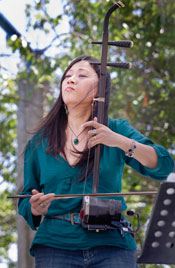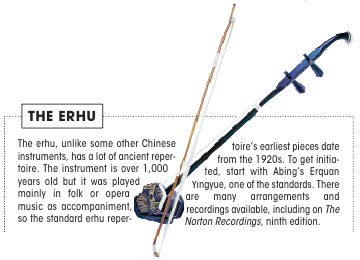Flash version here.
 Lan Tung inhabits a space of paradox:
as a soloist and collaborator, a performer and composer, she sits at
the crossroads between the East and the West, innovation and tradition.
No wonder she founded an ensemble named Birds of Paradox. That particular
project brings together Indian, Celtic and Chinese musical influences,
but her many other projects—the JUNO-nominated Orchid Ensemble, the
Vancouver Inter-Cultural Orchestra, and Tandava being the main ones—are
no less melting pots of style.
Lan Tung inhabits a space of paradox:
as a soloist and collaborator, a performer and composer, she sits at
the crossroads between the East and the West, innovation and tradition.
No wonder she founded an ensemble named Birds of Paradox. That particular
project brings together Indian, Celtic and Chinese musical influences,
but her many other projects—the JUNO-nominated Orchid Ensemble, the
Vancouver Inter-Cultural Orchestra, and Tandava being the main ones—are
no less melting pots of style.
Taiwanese-born erhu player Tung is
based in Vancouver, but her playing takes her on extensive, diverse
tours. Often, she’s soloing with an orchestra one week and playing
for a visual arts/media or dance performance the next. In between gigs
she studies fiddle-instruments around the globe with players of all
stripes—from the erhu, with principal players in China, Taiwan, Canada
and the U.S. to improvisation with violinist Mary Oliver in Amsterdam,
Hindustani classical music with Kala Ramnath in Bombay, Egyptian music
and maqam with Dr. Alfred Gamil in Cairo, graphic scores and improvisation
with Barry Guy in Switzerland, and vocal music and music therapy, to
boot. Her projects straddle world, new, chamber, orchestral, and multidisciplinary
music. The myriad influences show up in her compositions and improvisations.
This is nothing new, she observes:
the meeting point of cultures “has been an inspiration for musicians
around the world for centuries,” she says. “It’s very natural
that musicians are interested in hearing different styles of music being
mixed together. There may be a clash, a contradiction, but it’s also
where you get the new sounds to come out. I really enjoy playing with
the tension between the differences and the common places.”
If versatility is her calling card
when it comes to musical genres, ironically, it isn’t when it comes
to her instrument. Although Tung studied piano and guitar briefly while
completing her post-secondary degrees, she has rarely strayed from the
erhu since picking it up for the first time at age 10. “I have a collection
of other fiddle instruments from many different countries that I think
maybe I’ll learn to play—but I just haven’t got time to learn
any of it!” she says. “There’s still more to learn with the erhu.”
Yet, learning erhu was no more than a matter of convenience at the time.
“I just wanted to learn any musical instrument,” she explains. “Economically,
Taiwan was still in the beginning of the big rise and so not that many
families could afford a piano, piano lessons. When the Chinese orchestra
[at school] started, it was a chance to learn musical instruments for
free. I joined right away.”
The erhu is commonly described as
a Chinese violin. It’s a useful point of comparison: they’re both
wooden stringed instruments in the soprano voice range—the erhu with
a smaller two and a half octave range—played with a horse-hair strung
bow. But the erhu is held vertically on the player’s lap and the bow
is placed between the two—instead of four—strings. You put rosin
on both sides of the bow and one side plays one string and the other,
the second. The underhand bow hold is more similar to a double bass
German bow hold than the one used for violin—similar to the way you
hold chopsticks. There is no fingerboard: fingers press against the
strings suspended over, instead of on, the wood. All this means the
erhu can be played longer with less fatigue; pitch can be manipulated
not only by moving up and down the fingerboard but also by varying the
pressure on the strings, allowing for a second style of vibrato. Of
course, there are differences between the prototypical erhu instruments
and the standard classical erhu—there are over 50 variations of related
folk instruments from China. The strings were traditionally made of
silk but are now commonly made of steel; Beijing opera instruments were
made of bamboo, southern ones of coconut.
Far from being tired of comparing
the violin with the erhu, Tung believes the interplay between the familiar
and the exotic is what makes intercultural and inter-genre music affecting
and inventive. “When people listen to music, they naturally reference
what they’re familiar with,” she explains. Listening to music “is
very subjective and based on people’s experience. It may not be what
the musicians or composer intends, but that’s fine because that’s
what makes it work. For example, in my compositions I sometimes use
Chinese melodies and then I’ll twist them, make changes to them: the
modes, the notes. That’s really interesting to me because the ear
is used to something and then you create a challenge by having a new
sound. This is why I haven’t got time to learn different instruments!
I’m learning music, not just Chinese music or the erhu. I get to learn
musical languages.”
She pauses, then concludes: “There
is so much more in music if you take away the boundaries between traditional
and contemporary and see only music.”
www.lantungmusic.com
Lan Tung solos on erhu with the
Orchestre Metropolitain in Mark Armanini’s
Heartland:
• January 25, Église Notre-Dame-des-Sept-Douleurs, Verdun
• January 26, Maison symphonique, Montreal
• January 28, Salle Désilets du Cégep Marie-Victorin, Rivière-des-Prairies
www.orchestremetropolitain.com



